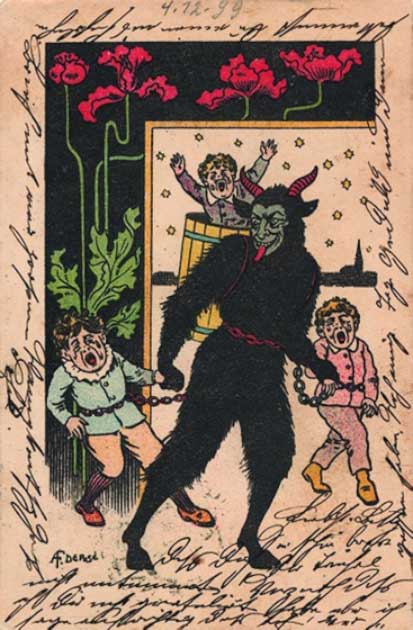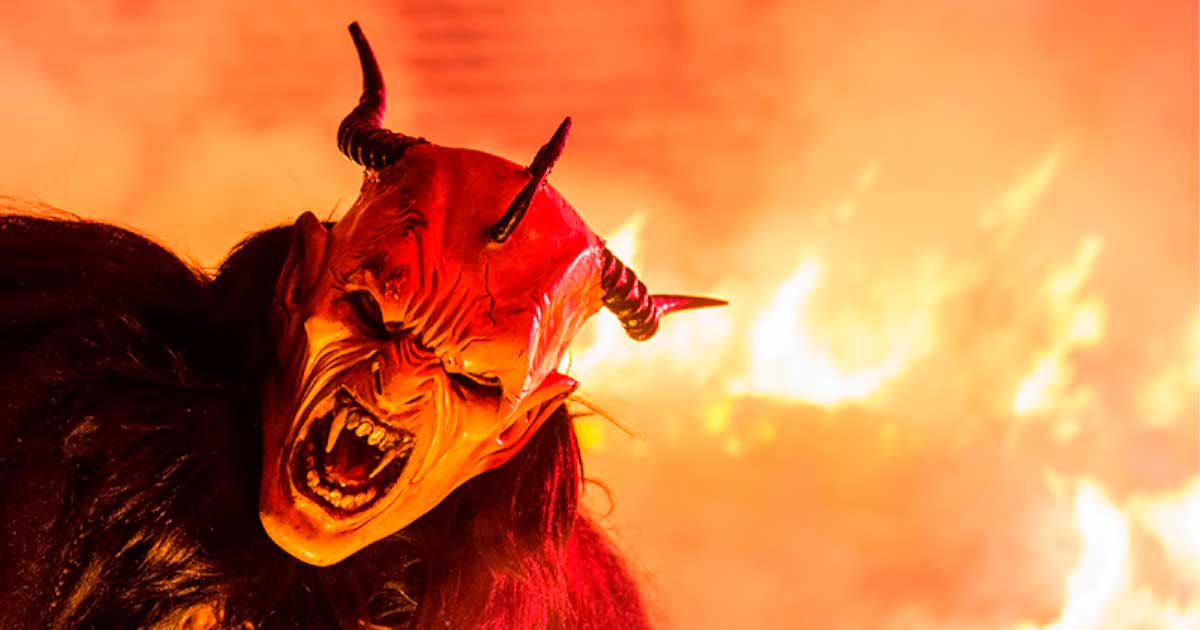Krampus: The Terrifying Christmas Devil Who Punished Naughty Children
In European folklore, Krampus is the antithesis of Santa Claus. The equivalent of a Christmas Devil, Krampus is a horrific beast that hunted down misbehaving children and whipped or terrified them into submission.
Originally an ancient pagan tradition, Krampus was coopted into the story of Saint Nicholas. Since then, he has been rallied against by medieval clergymen and repressed by nationalists only to be revived in an era of mass consumerism. Today, practitioners are worried about how the influx of refugees will respond to the terrifying Christmas Devil.

The Krampus of German-speaking folklore is a horned Christmas Devil who punishes naughty children. (Public domain)
Krampus: Christmas Devil and Son of Norse Goddess Hel
The Krampus tradition is popular in countries such as Germany, Austria, Hungary, Slovenia, and the Czech Republic. The name derives from the German word krampen, meaning claw. According to Jennifer Billock in the Smithsonian Magazine, Krampus had a “mangled, deranged face with bloodshot eyes atop a furry black body. Giant horns curl up from his head, displaying his half-goat, half-demon lineage.”
Legend has it that Krampus was the son of the Norse goddess Hel, ruler of Helheim, the Norse realm of the dead. Youngest daughter of Loki, in Encyclopedia Mythica Hel is described as “a horrible hag, half alive and half dead, with a gloomy and grim expression. Her face and body are those of a living woman, but her thighs and legs are those of a corpse, mottled and moldering.”
In essence, Krampus is a counterpart to other Christmas Devils such as France’s Hans Trapp and the Netherlands’ Zwarte Piet or Black Peter. The pagan tradition involved people, mostly young men, dressing up to scare away winter’s ghosts, usually fearful mountain spirits that liked to come down and wreak havoc.
Wearing fur suits and carved masks, they paraded through the villages yelling, ringing bells, and generally making a racket. The custom was oftentimes carried out on the longest night of the year, the Winter Solstice. Along with other pagan traditions, Krampus became entwined with Christmas as Christianity spread through Eastern Europe.

According to tradition, Krampus devours naughty children. (Public domain)
Krampus Devours Naughty Children
About 1,500 years ago, Krampus became the counterpart of Saint Nicholas. On the night of December 5/6, Saint Nicholas was (and is) said to walk about, leaving little presents in the shoes and boots of well-behaved children.
Local folk legends claimed that following close behind was Krampus, who set about leaving a rod in the shoes of children who had been naughty. Krampus was even said to carry a bundle of birch sticks with which to strike the bad children.
The worst offenders were stuffed into a bag and dragged off to his lair where they would presumably be eaten. “Together, the Krampus-like figures and the bishop St. Nicholas… held a kind of judgment day for children,” explained Becky Little in National Geographic.

Krampus the Christmas Devil. (pixelleo / Adobe Stock)
Krampus is Not So Easy to Banish!
By the 12th century, the Catholic Church began its work to stamp out this pagan devil. Christians were fairly successful at banishing the Krampus until he reemerged in a 19th-century fit of consumerism. “Manufacturers started to commercialize Krampus after 1890, when the Austrian government relinquished control over the nation’s postcard production, causing the industry to flourish,” explained Little.
There were scary Krampuses for children and silly Krampuses for adults. This coincided with a revival of Krampus festivals. Although ostensibly supposed to scare children into good behavior, the night allowed adults (mostly men) to dress up in scary costumes and run around the town, usually drunk.
It is the Krampuslauf (or “Krampus Run”) aspect of the Krampusnacht (“Krampus Night”) that is most popular today. But the early 20th-century Krampuslauf was outlawed by the conservative and nationalist parties of Germany and Austria in the 1930s.
The Rise of Krampus, the Christmas Devil
Today, Krampus is making a comeback in Europe and is gaining popularity in America. This is “thanks partly to a ‘bah, humbug’ attitude in pop culture, with people searching for ways to celebrate the yuletide season in non-traditional ways,” explained National Geographic.
Krampus’ rise in America has mirrored a rise in the number of people who bemoan that the tradition has become too commercialized. They are especially distraught about the 2015 comedy / horror film centered on the Christmas Devil.
“The Krampus is the yin to St. Nick's yang,” said Jeremy Seghers, organizer of a Krampus festival in Orlando, Florida, when speaking to Smithsonian Magazine. “You have the saint, you have the devil. It taps into a subconscious macabre desire that a lot of people have that is the opposite of the saccharine Christmas a lot of us grew up with.”

There has been a recent revival of Krampus festivals, during which adults dress up in scary costumes. (haldos / Adobe Stock)
Attempts to Stop Krampus Scaring Refugees
More worrying than Hollywood attempts to capitalize on the tradition, a new wrinkle in the Krampus story has recently arisen concerning the influx of refugees. “Though the festival is well-loved, it gave rise to concerns that the new neighbors might be scared of the tradition and its nightmare-fueling costumes,” wrote Jennifer Billock in Smithsonian Magazine.
Some called for the annual Krampus festival to be canceled. One city in Austria instead chose to introduce the newcomers to their tradition by inviting children to a display of Krampus costumes and props before the big night.
- Christkind: How Does this Christmas Gift-Bringer Differ from Santa Claus?
- Why Do Christmas Ghost Stories Have Such Enduring Appeal?
“I think it's wonderful that they want to get the refugees used to this sort of thing,” said Seghers. “You can’t force people to adopt cultural traditions of which they have no basis or point of reference.”
Speaking with a reporter from The Telegraph, two local participants offered similar views: “For people who have never seen it, it can be somewhat intimidating,” said Bettina Huber, a local volunteer working on the project. “They had no idea about this [tradition], and were totally surprised. It's good that they see what happens,” said Paulo Keliny, an Arab translator from Egypt.
Top image: Krampus is a Christmas Devil. Source: Sergio Delle Vedove / Adobe Stock
By Kerry Sullivan
References
Basu, T. 19 December 2013. “Who Is Krampus? Explaining the Horrific Christmas Devil.” in National Geographic. Available at: http://news.nationalgeographic.com/news/2013/12/131217-krampus-christmas-santa-devil/
Billock, J. 4 December 2015. “The Origin of Krampus, Europe’s Evil Twist on Santa” in Smithsonian Magazine. Available at: http://www.smithsonianmag.com/travel/krampus-could-come-you-holiday-season-180957438/
Lindemans, M. F. 03 Mar. 1997. “Hel” in Encyclopedia Mythica. Available at: https://pantheon.org/articles/h/hel.html
Little, B. 3 December 2015. “How Krampus, the Christmas 'Devil,' Became Cool.” in National Geographic. Available at: http://news.nationalgeographic.com/2015/12/151204-krampus-movie-christmas-demon-santa-holiday-folklore/
Little, B. 18 December 2020. “Meet Krampus, the Christmas Devil Who Punishes Naughty Children” in History. Available at: https://www.history.com/news/krampus-christmas-legend-origin
Sabur, R. 30 November 2015. “Austrian Town Reassures Asylum-seekers over Unusual Christmas Tradition” in The Telegraph. Available at: http://www.telegraph.co.uk/news/worldnews/europe/austria/12024686/Austrian-town-reassures-asylum-seekers-over-unusual-Christmas-tradition.html


















Comments
Still reminds me of the old joke " dyslexic christmas fans shout 'hail satan'".. its not that much of a joke to me.. the red outfit, the gifts for the good the severe punishment for the naughty.. thats what the accuser spirit was originally meant to do before he fell for lucifers ego
infinitesimal waveparticles comprise what we call home the earth
manipulatable by thought ability supressed in humans since birth
Are immigrant children more feeble and less resilient? That would seem to be the implication, however unintentional, of a ban because of new neighbours, which sounds a wee bit, you know...
Be that as it may, accustoming immigrant children to the tradition is not necessarily advantageous. Some traditions are best left to wither if no longer understood, less they be hijacked as Krampus has been of late.